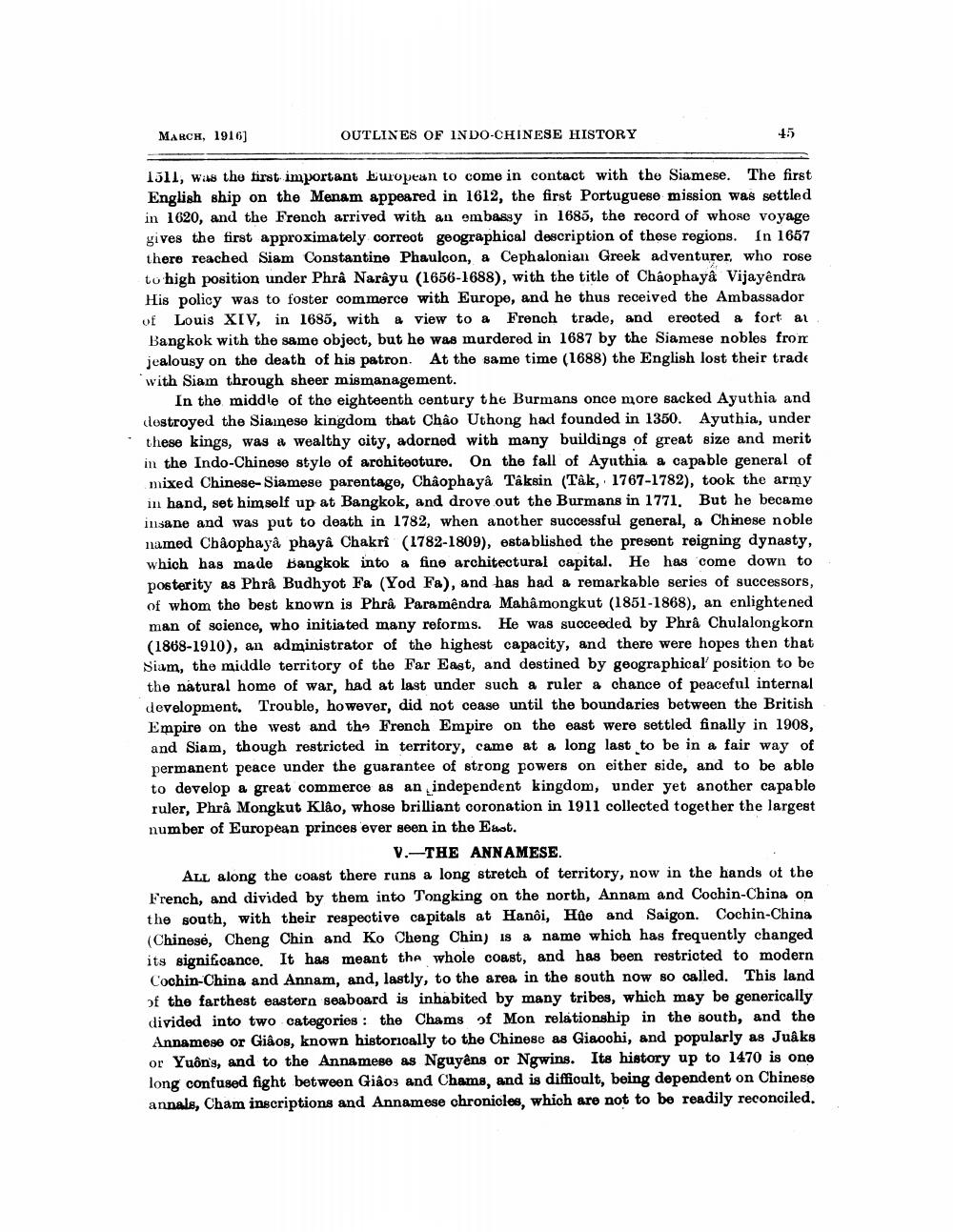________________
MARCH, 1916)
OUTLINES OF INDO-CHINESE HISTORY
1511, wins the first important European to come in contact with the Siamese. The first English ship on the Menam appeared in 1612, the first Portuguese mission was settled in 1620, and the French arrived with an embassy in 1685, the record of whose voyage gives the first approximately correct geographical description of those regions. In 1657 there reached Siam Constantine Phauloon, a Cephalonian Greek adventurer, who rose to high position under Phra Narayu (1656-1688), with the title of Chaophayá Vijayêndra His policy was to foster commerce with Europe, and he thus received the Ambassador of Louis XIV, in 1685, with a view to a French trade, and erected & fort ar Bangkok with the same object, but he was murdered in 1687 by the Siamese nobles from jealousy on the death of his patron. At the same time (1688) the English lost their trade with Siam through sheer mismanagement.
In the middle of the eighteenth century the Burmans once more backed Ayuthia and destroyed the Siainese kingdom that Châo Uthong had founded in 1350. Ayuthia, under these kings, was a wealthy city, adorned with many buildings of great size and merit in the Indo-Chinese style of architeoture. On the fall of Ayuthia a capable general of mixed Chinese-Siamese parentage, Châophayâ Tâksin (Tåk, 1767-1782), took the army in hand, set himself up at Bangkok, and drove out the Burmans in 1771. But he became insane and was put to death in 1782, when another successful general, a Chinese noble named Chaophayâ phaya Chakri (1782-1809), established the present reigning dynasty, which has made Bangkok into a fine architectural capital. He has come down to posterity as Phrå Budhyot Fa (Yod Fa), and has had a remarkable series of successors, of whom the best known is Phrâ Paramêndra Mahâmongkut (1851-1868), an enlightened man of science, who initiated many reforms. He was succeeded by Phra Chulalongkorn (1868-1910), an administrator of the highest capacity, and there were hopes then that Siam, the middle territory of the Far East, and destined by geographical position to be the natural home of war, had at last under such a ruler & chance of peaceful internal development. Trouble, however, did not cease until the boundaries between the British Empire on the west and the French Empire on the east were settled finally in 1908, and Siam, though restricted in territory, came at a long last to be in a fair way of permanent peace under the guarantee of strong powers on either side, and to be able to develop a great commerce as an independent kingdom, under yet another capable ruler, Phrâ Mongkut Klâo, whose brilliant coronation in 1911 collected together the largest number of European princes ever seen in the East.
V.-THE ANNAMESE. ALL along the coast there runs a long stretch of territory, now in the hands of the French, and divided by them into Tongking on the north, Annam and Cochin-China on the south, with their respective capitals at Hanôi, He and Saigon. Cochin-China (Chinese, Cheng Chin and Ko Cheng Chin) is a name which has frequently changed its significance. It has meant the whole coast, and has been restricted to modern Cochin-China and Annam, and, lastly, to the area in the south now so called. This land of the farthest eastern seaboard is inhabited by many tribes, which may be generically divided into two categories : the Chams of Mon relationship in the south, and the Annamese or Giâog, known historically to the Chinese as Giaoohi, and popularly as Juâks or Yuôn', and to the Annamese as Nguyêns or Ngwins. Its history up to 1470 is one long confused fight between Giâos and Chams, and is diffioult, being dependent on Chinese annals, Cham inscriptions and Annamese chronicles, which are not to be readily reconciled.




